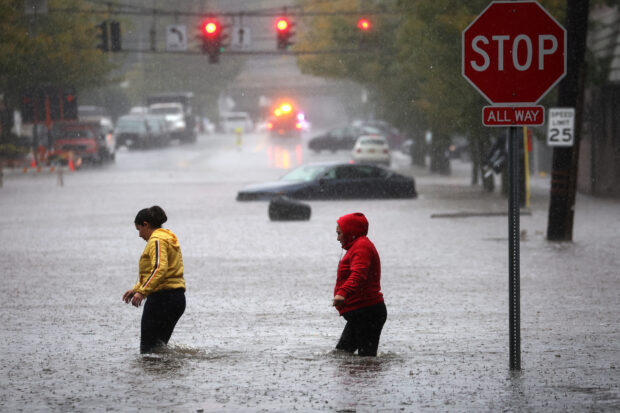
Residents walk through floodwaters during a heavy rain storm in the New York City suburb of Mamaroneck in Westchester County, New York, U.S., September 29, 2023. (REUTERS)
NEW YORK – Torrential downpours after a week of mostly steady rainfall triggered flash flooding in New York City on Friday, disrupting subway service in the most populous U.S. city and turning some streets into small lakes.
A flash flood warning was in effect for New York City until midday, with as much as 6 inches (15 cm) of rain falling in some locations, including Brooklyn, lower Manhattan and John F. Kennedy International Airport in the borough of Queens, said Zack Taylor of the National Weather Service.
Across the region, another 2 to 3 inches (5 to 8 cm)of rain could fall throughout the day and into the night, but some locations could see even more, said Taylor, a meteorologist with the service’s Weather Prediction Center in College Park, Maryland
“This is seriously a life-threatening situation,” he said.
Taylor warned against travel until the weather system pulls away from the coast later on Friday evening.
The extreme rainfall prompted New York Governor Kathy to declare a state of emergency for New York City, Long Island, and the Hudson Valley.
“Please take steps to stay safe and remember to never attempt to travel on flooded roads,” she said in a message posted on X, formerly known as Twitter.
Flooding caused major disruptions to New York’s subway system and the Metro North commuter rail service, according to the Metropolitan Transportation Agency. Some subway lines were suspended entirely, including the G, which connects Brooklyn and Queens, and many stations were closed.
Global warming has resulted more extreme weather patterns in many parts of the world, according to climate scientists. Systems producing intense rainfalls have become more commonplace in many parts of the United States, including the New York City area, in recent years.
On Friday, some 18 million people in the New York metropolitan area and in other major cities along the East Coast were under flood warnings, watches and advisories from the weather service.
Despite the warnings, public schools in New York City were open for the day, although at least one suburban district, Bronxville in New York’s Westchester County north of the city, dismissed students early because of the worsening flooding.
Photographs and video footage from across the New York area showed floodwater submerging vehicles on neighborhood streets and water drenching the inside of subway stations, disrupting morning traffic for millions of commuters.
In The Hole, a residential area on the border of Brooklyn and Queens and one of the lowest-lying parts of the city, Carlos Ogando had donned rubber boots and was using a water pump and an orange bucket to attack his house’s flooded basement.
He had been dumping water down the toilet, a task made more grim by the sewage backing up.
Low-lying Hoboken, a New Jersey city directly across the Hudson River from lower Manhattan, declared a state of emergency, with all but one of the southern routes into town under water.
The city’s newly installed floodgates, designed to close automatically when water pooled on roadways, were down, blocking many streets to vehicular traffic.
The deluge followed a bout of heavy downpours and unrelenting winds last weekend from the remnants of Tropical Storm Ophelia. That storm soaked New York City and caused widespread power outages in North Carolina, Virginia, Pennsylvania and New Jersey.
In New York, intermittent rain this week further saturated the ground, setting up conditions conducive to flash flooding.